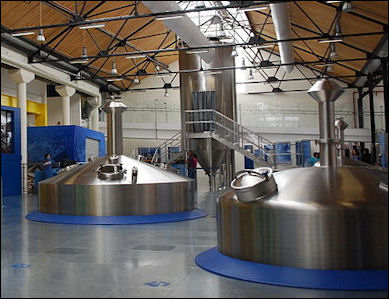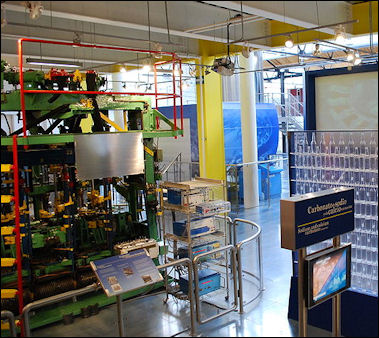BEER

Grist and Mash Beer has traditionally been associated with countries of northern Europe because grain grows better there whereas the grapes used for wine usually grow better in hotter, dryer climates of southern Europe.
World’s Top Producers of Beer (made with Barley) (2019): 1) China: 37653000 tonnes; 2) United States: 21088400 tonnes; 3) Brazil: 17143518 tonnes; 4) Mexico: 12450242 tonnes; 5) Germany: 8040566 tonnes; 6) Russia: 7692420 tonnes; 7) Vietnam: 4600000 tonnes; 8) Spain: 3930000 tonnes; 9) United Kingdom: 3924700 tonnes; 10) South Africa: 3250000 tonnes; 11) Japan: 2800000 tonnes; 12) Netherlands: 2412800 tonnes; 13) India: 2400000 tonnes; 14) Colombia: 2394427 tonnes; 15) France: 2250000 tonnes; 16) Philippines: 2220000 tonnes; 17) Thailand: 2172100 tonnes; 18) Czechia: 2160800 tonnes; 19) Canada: 2160000 tonnes; 20) Argentina: 1955900 tonnes. [Source: FAOSTAT, Food and Agriculture Organization (U.N.), fao.org. A tonne (or metric ton) is a metric unit of mass equivalent to 1,000 kilograms (kgs) or 2,204.6 pounds (lbs). A ton is an imperial unit of mass equivalent to 1,016.047 kg or 2,240 lbs.]
Top beer producers in 2003: 1) China (25.1 million kiloliters, 17.1 percent of the world’s production, 7 percent increase from the previous year); 2) the United States (23.08 million kiloliters, 15.6 percent of the world’s production, 1.6 percent decrease from the previous year); 3) Germany (10.53 million kiloliters, 6.5 percent of the world’s production, 2.1 percent decrease from the previous year); 4) Brazil (8.52 million kiloliters, 5 percent of the world’s production, 2.3 percent increase from the previous year); 5) Russia (7.57 million kiloliters, 4/5 percent of the world’s production, 7.8 percent increase from the previous year); 6) Mexico (6.64 million kiloliters, 4 percent of the world’s production, 4.3 percent increase from the previous year); 7) Japan (6.53 million kiloliters, 4 percent of the world’s production, 6.5 percent decrease from the previous year). [Source: Kirin Brewery]
The top 5 beer making countries in 1998 (tons per year): 1) USA (23,655,000); 2) Germany (11.806,000); 3) China (6,926,000); 4) Japan (6,232,000); 5) the UK (6,006,000).
Websites and Resources: Michael Jackson’s Beer Hunter /michaeljacksonthebeerhunter.blogspot.com ; Michael Jackson’s Beer Style Index beerhunter.com/beerstyles.html ; Realbeer.com realbeer.com ; Wikipedia article Wikipedia ; Beer Advocate /beeradvocate.com ; Types of Beer thenibble.com/reviews/main/beer/glossary ; Beer Type Chart drinkingbeer.net/BeerArticles/Beer_Types ; Beer Style Guidelines brewersassociation.org ; Wikipedia article on History of Beer Wikipedia ; History of Beer Comics manolith.com ; Foaming Head Beer History thefoaminghead.com/history ; Beer Production Charts hyfoma.com ; Beer Production in Pictures inwithbacchus.com/2010/10/in-with-bacchus-guide- ; Book: “Beer Essentials” by F. Paul Pacult (1997)
Cask Beer
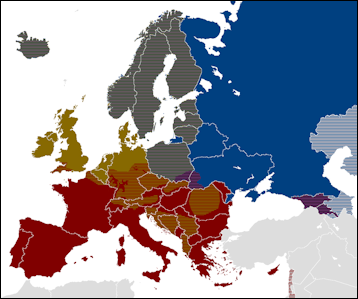
European alcohol belt, beer in brown
Before beer was industrialized it was unpasteurized and unfiltered, and naturally carbonated or conditioned in its casks by yeast transforming sugar into alcohol. Modern beers are filtered and pasteurized for stable shelf life. Most drafts beers are injected with carbon dioxide, filtered and often pasteurized and stored in pressurized kegs and served through gas-powered taps.
Cask beer is about the closest thing you can get to beer made in the pre-industrial age. The beer is placed into a cask. In the old days they were generally made of wood but now are made of metal. A small dose of sugar is added to produce a secondary fermentation, sort of like with champagne. Brewers may add more hops or a fining material such as isinglass to help settle the yeast and clarify the beer. When they are ready cask beers have to be handled carefully. They have a shelf life of two to four days and have to be tapped correctly or the results are disappointing. Because they aren’t charged with carbon dioxide, bartenders have to work hard to pump it.
The New York Times wine critic Eric Asimov wrote: “Because cask ales are naturally carbonated and best served at cellar temperature — about 55 degrees F — they have been described as warm and flat. But as you get to know them, it can be hard to imagine drinking beer any other way. The softness of the bubbles and the gently cool temperatures permit nuances that otherwise would be undetectable.”
Beer Ingredients
Most beers are only made with four ingredients: barley-malt, hops, yeast and water. Sometimes wheat, corn, oats, rye or rice are added to barley for taste. These are often called beer adjuncts. Two-row barely, in which grains grow in two lines around the cob, is the kind of barely usually used to make beer. It is suited for beer production because the large grains have a high starch content and suitable levels of carbohydrates and membranes are appropriately thin. Malt is barley or another grain that has been artificially germinated or sprouted by moisture and heat. Maltose is a kind of sugar produced from starch by malting.
Hops are herbal flowers. They act as a preservative; give beer its balancing bitterness when boiled; suppress the breeding of bacteria in beer; and play a key role helping bubble form and remain in the beer. At the base of the flowers of fully matured female hops plants are small, golden grains called “lupulin.” Two key beer ingredients are found in each pod: bitter-tasting hops resin and aroma-providing hops oil.
The water used in brewing beer must be colorless, odorless, transparent, pure-tasting and microbe-free. The mineral content of the water has a crucial effect on the conversion of the mash’s starch content to sugar, as well as on the fermentation process. This is why the quality of water is so crucial for the quality of beer. Soft water is generally considered best for making pale beers, while hard water is required for darker beers.
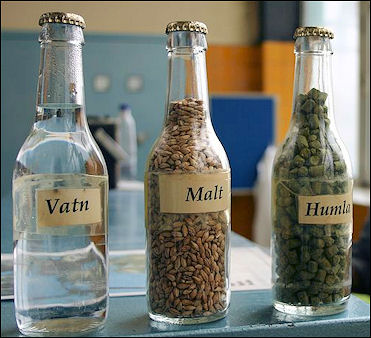
Yeast is a microbe that is essential to brewing beer. It decomposes maltose (sugars in roasted grain) into alcohol and carbonated gas is crucial to the final flavor. Yeast can be spherical or oval in shape and generally measure less than 1/100 of a millimeter in size. More than 10 billion yeast microbes can fit a single cup. There are many varieties of yeast, each with its own brewing strengths and special characteristics that ultimately give beer its taste and aroma. Details are Yeast strains are often carefully guarded secrets and copies are kept in case a mistake or an accident kills the yeast.
Hops adds aroma, body and bitterness to beer. In the late 2000s there was a shortage of hops and brewers worldwide worried if they could secure enough supplies. The shortages dated by the late 1990s when there was a glut of hops and prices reached an all time low and growers stopped producing it.
Researchers at Oregon State University have found that xanthohumal, a compound found in hops and beer, prevents prostrate cancer by inhibiting a protein in the cells along the surface of the prostrate gland. The protein acts like a switch that turns on many cancers, including prostrate cancer. The problem is that one has to drink about 17 cans of beer a day to receive any potential benefit.
Making Malt
Beer starts with sprouted barely, which is moistened and allowed to geminate, a process called malting. This converts starches into sugar called maltose, which is then fermented, producing alcohol as one of its byproducts. After its is harvested the barely used to make beer is stored for two or three months before it is sprouted.
It takes about 10 days for the barely to turn to malt. During the malting process various enzymes are produced by fermentation. One of the most important is “diastase”, which has the ability to change starch into sugar. In addition to brewing beers, malt is used in making malted milks and baby food (the malting process has the same effect as partial digestion).
Malted barley is often made by adding water and aerating the mixture to stimulate germination and then halting he germination process by allowing the mixture to dry. This can be done by steeping the grain in cisterns from 48 to 100 hours at a temperature of about 55̊F, then spreading it on a floor to germinate, and, afterwards, drying it. When the process is finished the roots are removed, leaving malted barley.
Making Beer
inside a brewery The crushed malt ferments naturally after yeast and hot water are added. The amount of water used in beer production is seven or eight time the volume of the of the final product. The main waste material is malt-feed which is collected and sold as cattle feed.
In the mashing process: 1) Malt and beer adjuncts such as rice, corn and starches are placed in a room-size mash kettle with hot water and brought to a boil. 2) Hot water and barely are added to malt boiling in the mass kettle. The starch content of the liquid changes to maltose. 3) The mixture created in the mash tun is filtered in the lauter tun to obtain the transparent wort. And 4) hops is added to the wort while boiling in the brew kettle to give beer its special aroma and taste.
Beer is fermented and matured in separate tanks, Beer yeast is added to well-chilled wort to start fermentation. The sugar in the wort decomposes into alcohol and fermented gas, creating “green” beer after about a week. In the maturation tanks the beer is matured for a few dozen weeks. After the beer has matured it is filtered, producing beer that is ready to drink.
To determine when he fermentation process is complete, beer brewers use technology that measures gas levels in the space above the head, or foam of the beer. The "head space" equipment consist of two glass bowls that form a globe and trap the air inside. The air is then transferred through a cylinder of absorbent material called Tenax that is sealed when it is filled. The cylinders are taken to a lab and the gases inside are analyzed to check if fermentation is complete.
When it is determined that fermentation is complete the beer is then bottled or canned. Carbon dioxide is usually injected during the bottling process. After a final visual inspection and fill-height check the product is ready for shipment.
World’s Top Beer Exporting Countries
World’s Top Exporters of Beer (2020): 1) Mexico: 3225416 tonnes; 2) Netherlands: 1879572 tonnes; 3) Belgium: 1787630 tonnes; 4) Germany: 1513024 tonnes; 5) France: 526369 tonnes; 6) Czechia: 507078 tonnes; 7) United Kingdom: 462100 tonnes; 8) Ireland: 456930 tonnes; 9) Poland: 406674 tonnes; 10) China: 386744 tonnes; 11) United States: 386740 tonnes; 12) Russia: 361599 tonnes; 13) Spain: 347523 tonnes; 14) Italy: 331461 tonnes; 15) Denmark: 296543 tonnes; 16) Portugal: 207634 tonnes; 17) Brazil: 174428 tonnes; 18) Ukraine: 143955 tonnes; 19) Canada: 141540 tonnes; 20) Serbia: 135283 tonnes. [Source: FAOSTAT, Food and Agriculture Organization (U.N.), fao.org]
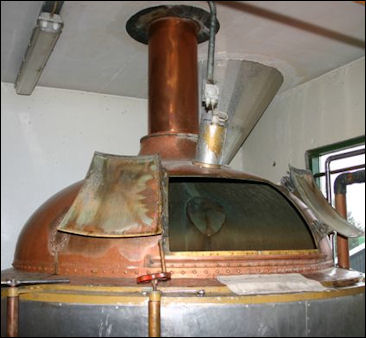
fermenting tanks
World’s Top Exporters (in value terms) of Beer (2020): 1) Mexico: US$4252177,000; 2) Netherlands: US$2165760,000; 3) Belgium: US$1984828,000; 4) Germany: US$1272031,000; 5) United States: US$645563,000; 6) United Kingdom: US$528582,000; 7) France: US$376545,000; 8) Czechia: US$306417,000; 9) Spain: US$292334,000; 10) Ireland: US$290917,000; 11) Denmark: US$256305,000; 12) Italy: US$253661,000; 13) China: US$242754,000; 14) Poland: US$241350,000; 15) Portugal: US$153368,000; 16) Russia: US$130500,000; 17) Canada: US$103321,000; 18) Thailand: US$93615,000; 19) Brazil: US$92778,000; 20) Singapore: US$86651,000
World’s Top Beer Importing Countries
World’s Top Importers of Beer (2020): 1) United States: 4268830 tonnes; 2) United Kingdom: 1063576 tonnes; 3) France: 1023630 tonnes; 4) Germany: 683283 tonnes; 5) Italy: 611906 tonnes; 6) China: 584229 tonnes; 7) Netherlands: 558789 tonnes; 8) Spain: 523108 tonnes; 9) Russia: 501610 tonnes; 10) Ireland: 362962 tonnes; 11) Canada: 322090 tonnes; 12) South Korea: 277930 tonnes; 13) Australia: 215066 tonnes; 14) Taiwan: 213228 tonnes; 15) Belgium: 211312 tonnes; 16) Hungary: 172542 tonnes; 17) Slovakia: 171275 tonnes; 18) Belarus: 165386 tonnes; 19) Paraguay: 160547 tonnes; 20) Chile: 158800 tonnes. [Source: FAOSTAT, Food and Agriculture Organization (U.N.), fao.org]
World’s Top Importers (in value terms) of Beer (2020): 1) United States: US$5977473,000; 2) France: US$1029930,000; 3) China: US$695086,000; 4) United Kingdom: US$674681,000; 5) Italy: US$546445,000; 6) Netherlands: US$489008,000; 7) Canada: US$484771,000; 8) Germany: US$457799,000; 9) Russia: US$369283,000; 10) Spain: US$338845,000; 11) Australia: US$285600,000; 12) Ireland: US$284682,000; 13) South Korea: US$226920,000; 14) Taiwan: US$205516,000; 15) Chile: US$177921,000; 16) Belgium: US$171646,000; 17) Sweden: US$135290,000; 18) Switzerland: US$117324,000; 19) Paraguay: US$115213,000; 20) Hong Kong: US$115037,000
World’s Top Hops Producing Countries
World’s Top Producers of Hops (2020): 1) Ethiopia: 47323 tonnes; 2) United States: 47090 tonnes; 3) Germany: 46900 tonnes; 4) China: 7837 tonnes; 5) Czechia: 5930 tonnes; 6) Poland: 3420 tonnes; 7) Slovenia: 2720 tonnes; 8) North Korea: 2025 tonnes; 9) Albania: 1746 tonnes; 10) Spain: 1040 tonnes; 11) New Zealand: 898 tonnes; 12) France: 700 tonnes; 13) Japan: 693 tonnes; 14) Australia: 606 tonnes; 15) Ukraine: 510 tonnes; 16) Austria: 500 tonnes; 17) Argentina: 471 tonnes; 18) South Africa: 445 tonnes; 19) United Kingdom: 395 tonnes; 20) Russia: 221 tonnes. [Source: FAOSTAT, Food and Agriculture Organization (U.N.), fao.org]
World’s Top Producers (in terms of value) of Hops (2019): 1) United States: Int.$268586,000 ; 2) Germany: Int.$256324,000 ; 3) Ethiopia: Int.$234349,000 ; 4) Czechia: Int.$37788,000 ; 5) China: Int.$37186,000 ; 6) Poland: Int.$19925,000 ; 7) Slovenia: Int.$13583,000 ; 8) Albania: Int.$11976,000 ; 9) North Korea: Int.$10496,000 ; 10) Spain: Int.$5126,000 ; 11) New Zealand: Int.$4661,000 ; 12) France: Int.$4069,000 ; 13) Japan: Int.$3573,000 ; 14) Australia: Int.$3441,000 ; 15) Austria: Int.$2748,000 ; 16) Ukraine: Int.$2695,000 ; 17) Argentina: Int.$2606,000 ; 18) South Africa: Int.$2495,000 ; 19) Romania: Int.$1163,000 ; [An international dollar (Int.$) buys a comparable amount of goods in the cited country that a U.S. dollar would buy in the United States.]
Top Producing Countries of Hops in 2008: (Production, $1000; Production, metric tons, , FAO): 1) Germany, 155642 , 39700; 2) United States of America, 143383 , 36573; 3) Ethiopia, 126870 , 32361; 4) China, 39204 , 10000; 5) Czech Republic, 26474 , 6753; 6) Poland, 13686 , 3491; 7) Slovenia, 9409 , 2400; 8) Democratic People's Republic of Korea, 7448 , 1900; 9) United Kingdom, 5880 , 1500; 10) France, 5759 , 1469; 11) Albania, 3920 , 1000; 12) Ukraine, 3567 , 910; 13) Spain, 3528 , 900; 14) Australia, 3367 , 859; 15) New Zealand, 3136 , 800; 16) Japan, 2803 , 715; 17) Argentina, 1764 , 450; 18) Austria, 1505 , 384; 18) Bulgaria, 1505 , 384; 20) South Africa, 1411 , 360;
World’s Top Hops Exporting Countries
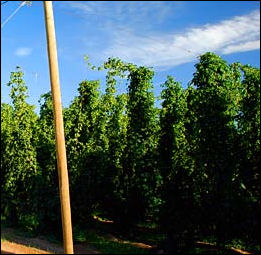
hops field World’s Top Exporters of Hops (2019): 1) Germany: 25213 tonnes; 2) United States: 12554 tonnes; 3) Czechia: 4225 tonnes; 4) Slovenia: 3093 tonnes; 5) Poland: 2104 tonnes; 6) United Kingdom: 1680 tonnes; 7) Belgium: 1572 tonnes; 8) Bulgaria: 1465 tonnes; 9) Australia: 1034 tonnes; 10) Belarus: 503 tonnes; 11) France: 309 tonnes; 12) Ukraine: 179 tonnes; 13) South Africa: 175 tonnes; 14) China: 102 tonnes; 15) Russia: 93 tonnes; 16) Slovakia: 91 tonnes; 17) Denmark: 71 tonnes; 18) Canada: 63 tonnes; 19) Sweden: 52 tonnes; 20) Egypt: 50 tonnes. [Source: FAOSTAT, Food and Agriculture Organization (U.N.), fao.org]
World’s Top Exporters (in value terms) of Hops (2019): 1) Germany: US$276697,000; 2) United States: US$213660,000; 3) Czechia: US$48956,000; 4) Belgium: US$40260,000; 5) Slovenia: US$28283,000; 6) United Kingdom: US$25395,000; 7) Australia: US$18929,000; 8) Poland: US$12237,000; 9) Bulgaria: US$3386,000; 10) France: US$2874,000; 11) Ukraine: US$2000,000; 12) South Africa: US$1921,000; 13) Russia: US$1446,000; 14) Belarus: US$1436,000; 15) Sweden: US$1322,000; 16) Denmark: US$942,000; 17) New Zealand: US$898,000; 18) Canada: US$866,000; 19) Slovakia: US$864,000; 20) Lithuania: US$645,000
World’s Top Malt Importing Countries
Malt is germinated cereal grain that has been dried in a process known as "malting". The grain is made to germinate by soaking in water and is then halted from germinating further by drying with hot air. The malt used to make beer usually comes from barley, and to a lesser extent wheat. Other grains such as spelt, rye and oats are also used.
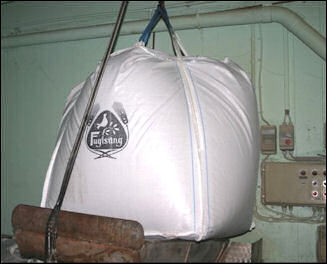
big bag of malt
World’s Top Importers of Malt (2019): 1) Brazil: 1091558 tonnes; 2) Mexico: 572799 tonnes; 3) Japan: 496353 tonnes; 4) Belgium: 445792 tonnes; 5) United States: 438777 tonnes; 6) Netherlands: 293203 tonnes; 7) Vietnam: 292077 tonnes; 8) Germany: 231576 tonnes; 9) Thailand: 214040 tonnes; 10) Poland: 200977 tonnes; 11) Nigeria: 190623 tonnes; 12) Philippines: 182165 tonnes; 13) South Korea: 169870 tonnes; 14) Cambodia: 158152 tonnes; 15) Italy: 148771 tonnes; 16) South Africa: 97073 tonnes; 17) Cameroon: 89744 tonnes; 18) Angola: 87961 tonnes; 19) Russia: 83764 tonnes; 20) Romania: 79859 tonnes. [Source: FAOSTAT, Food and Agriculture Organization (U.N.), fao.org]
World’s Top Importers (in value terms) of Malt (2019): 1) Brazil: US$543581,000; 2) Mexico: US$326716,000; 3) United States: US$306758,000; 4) Japan: US$280879,000; 5) Vietnam: US$197901,000; 6) Belgium: US$167478,000; 7) Netherlands: US$113027,000; 8) Thailand: US$102228,000; 9) Germany: US$97088,000; 10) Philippines: US$92803,000; 11) South Korea: US$91643,000; 12) Nigeria: US$87423,000; 13) Poland: US$86363,000; 14) Cambodia: US$83656,000; 15) Italy: US$75045,000; 16) Angola: US$67662,000; 17) South Africa: US$45330,000; 18) Cameroon: US$42532,000; 19) Russia: US$39738,000; 20) Romania: US$38184,000
Image Sources: Wikimedia Commons
Text Sources: National Geographic, New York Times, Washington Post, Los Angeles Times, Smithsonian magazine, Natural History magazine, Discover magazine, Times of London, The New Yorker, Time, Newsweek, Reuters, AP, AFP, Lonely Planet Guides, Compton’s Encyclopedia and various books and other publications.
Last updated March 2022

